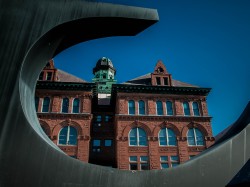
The pieces of our city tell the stories of generations past who loved and labored, hoped and dreamed, and helped form the world in which we live today.
When it comes to heirlooms, few are treasured as much as a quilt that has been handed down through the generations. There is just something wonderful about a handcrafted piece of history that keeps you warm in the winter and serves as a beautiful piece of art the rest of the year. Every old quilt tells a story of generations past who loved and labored, hoped and dreamed, and helped to form the world in which we live today. Swaths of fabric from various garments and scraps of “this and that” are held together by stitching that has often been repaired by succeeding generations who just may have added a patch or two from their own favorite garments.
In the old days, when the face of a quilt became too worn, many times it was refaced with yet another layer of beautiful patchwork. Layer after layer, family stories are preserved in these priceless possessions. Quilts pass through the ages and tell their stories because they are mended and cared for along the way. It is much the same way with our city.
Echoes of the Past
The story of Peoria is preserved all around us, much like the various pieces of a quilt. Myriad buildings in every conceivable style, shape, purpose and condition still stand to tell us about the wonderful days of our boom town past, the trying days of the Great Depression, and every era that has followed. Our City Hall was considered the finest amongst comparable cities in the nation at the time it was built. Great mansions line the bluffs and occupy unexpected spots in the valleys right alongside the cottages of dock workers, serving to tell us how people lived together through time. Warehouses speak of the volumes of freight that have passed through our city through the ages, inspiring us to think of what could once again rise from our river banks.
For more than three centuries, first European, and then American settlement has flourished in the area that is now Peoria. Prior to that, Native Americans were a part of this landscape for countless ages. Everywhere around us, echoes of that long and varied past exist. There is something rather indelible that binds us all together through the spans of time, like a tapestry made of a thousand threads woven together and bound by an intricate border.
Tending & Mending
Much like an actual quilt, the patchwork that is Peoria must be tended. The fabric pieces that make up our pattern need to be preserved, repaired and kept strong for a useful future. Sometimes, in a quilt, it is necessary to replace a few pieces of the pattern while others only need a little reinforcement or simple mending. It is much the same concept when it comes to keeping a city in good condition. We must identify the weak spots in this urban quilt and prudently repair them, while diligently guarding against the unnecessary removal of vital seams and pieces that keep the picture in balance.
when it comes to keeping a city in good condition. We must identify the weak spots in this urban quilt and prudently repair them, while diligently guarding against the unnecessary removal of vital seams and pieces that keep the picture in balance.
When making these repairs and improvements, we must remember that while our patches do not always need to be carbon copies of the original, we must be cautious in our choices. We should preserve the balance of the pattern and protect the integrity of what makes our urban quilt distinct from others while leaving our own marks along the way. It is important that we choose our own replacement parts of this quilt by choosing only the best and most durable materials. We need to pay homage to the pattern that was laid before us, while making certain that our own interpretations will be durable, a fitting testament to those who will someday enjoy this beautiful quilt and become its responsible keepers themselves. There is, however, another part that must not be forgotten.
Sharing Our Stories
Without sharing the history of a quilt, its symbols become lost to future generations. Of course, a beautiful quilt can be admired for its physical merits, but the story behind it makes it all the more luminous in the mind’s eye. Thus, it is imperative that we also take care to preserve and share the stories that are embedded in the extraordinary structures that have been left to us as the foundation of our quilt. It is a privilege and a civic duty to do so.
Too often, yet another house, another old store, yet another fragment of our memory is erased from the landscape, and piece by piece, our quilt becomes weaker and less vibrant. At the same time, we add to the edges and allow the center to decay. When we do so, we create a large, but fragile quilt that ultimately requires such a ponderous frame for support that it is unsustainable. Community, like fabric, is much stronger when closely woven.
It is increasingly important to learn to preserve and reuse our historic buildings while replacing the missing squares of the civic quilt in a responsible manner. It is the quilt of our history that distinguishes our community. The heritage tourism that remains untapped could certainly prove to be yet another quilt that keeps us warm for years to come. iBi
Marvin Forssander-Baird is a photographer and board member of the Central Illinois Landmarks Foundation. Formed in 1972, the organization works to foster the preservation of historic buildings and landmarks in the region. Visit its Facebook page at facebook.com/CILFPeoria.

